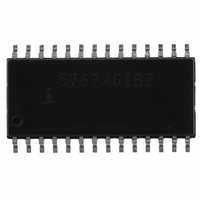HI5767/6IBZ Intersil, HI5767/6IBZ Datasheet - Page 12

HI5767/6IBZ
Manufacturer Part Number
HI5767/6IBZ
Description
CONV A/D 10BIT 60MSPS 28-SOIC
Manufacturer
Intersil
Datasheet
1.HI57672CBZ.pdf
(15 pages)
Specifications of HI5767/6IBZ
Number Of Bits
10
Sampling Rate (per Second)
60M
Data Interface
Parallel
Number Of Converters
8
Power Dissipation (max)
310mW
Voltage Supply Source
Analog and Digital
Operating Temperature
-40°C ~ 85°C
Mounting Type
Surface Mount
Package / Case
28-SOIC (0.300", 7.50mm Width)
Lead Free Status / RoHS Status
Lead free / RoHS Compliant
in a gain-of-two configuration. An external, user-supplied,
0.1µF capacitor connected from the V
analog ground is used to set the dominant pole and to
maintain the stability of the operational amplifier.
Reference Voltage Input, V
The HI5767 is designed to accept a +2.5V reference voltage
source at the V
converter requires V
tested with V
differential analog input voltage range of ±0.5V.
The user does have the option of supplying an external
+2.5V reference voltage. As a result of the high input
impedance presented at the V
typically, the external reference voltage being used is only
required to source 1mA of reference input current. In the
situation where an external reference voltage will be used
an external 0.1µF capacitor must be connected from the
V
the stability of the internal operational amplifier.
In order to minimize overall converter noise it is
recommended that adequate high frequency decoupling be
provided at the reference voltage input pin, V
Analog Input, Differential Connection
The analog input to the HI5767 is a differential input that can
be configured in various ways depending on the signal
source and the required level of performance. A fully
differential connection (Figure 17 and Figure 18) will deliver
the best performance from the converter.
Since the HI5767 is powered by a single +5V analog supply,
the analog input is limited to be between ground and +5V.
For the differential input connection this implies the analog
input common mode voltage can range from 0.25V to 4.75V.
The performance of the ADC does not change significantly
with the value of the analog input common mode voltage.
A DC voltage source, V
available to the user to help simplify circuit design when using
an AC coupled differential input. This low output impedance
voltage source is not designed to be a reference but makes
an excellent DC bias source and stays well within the analog
input common mode voltage range over temperature.
For the AC coupled differential input (Figure 17) and with
V
REFIN
REFOUT
FIGURE 16. AC COUPLED DIFFERENTIAL INPUT
connected to V
V
-V
IN
output pin to analog ground in order to maintain
IN
REFIN
REF IN
connected to V
REFIN
input pin. Typical operation of the
REFOUT
DC
, equal to 3.2V (typical), is made
to be set at +2.5V. The HI5767 is
12
R
R
REFIN
, full scale is achieved when
REFIN
REFOUT
input pin, 2.5kΩ
REFOUT
V
V
V
yielding a fully
DC
IN
IN
REFIN
-
+
HI5767
output pin to
.
HI5767
the V
180 degrees out of phase with V
positive full scale when the V
the V
Conversely, the converter will be at negative full scale when
the V
V
The analog input can be DC coupled (Figure 18) as long as
the inputs are within the analog input common mode voltage
range (0.25V ≤ VDC ≤ 4.75V).
The resistors, R, in Figure 18 are not absolutely necessary
but may be used as load setting resistors. A capacitor, C,
connected from V
frequency noise on the inputs, also improving performance.
Values around 20pF are sufficient and can be used on AC
coupled inputs as well. Note, however, that the value of
capacitor C chosen must take into account the highest
frequency component of the analog input signal.
Analog Input, Single-Ended Connection
The configuration shown in Figure 19 may be used with a
single ended AC coupled input.
Again, with V
sinewave, then V
voltage equal to VDC . The converter will be at positive full scale
when V
negative full scale when V
= -0.5V). Sufficient headroom must be provided such that the
input voltage never goes above +5V or below AGND. In this
case, VDC could range between 0.5V and 4.5V without a
significant change in ADC performance. The simplest way to
produce VDC is to use the DC bias source, V
HI5767.
DC
VDC
VDC
+ 0.25V (V
IN
IN
IN
V
FIGURE 18. AC COUPLED SINGLE ENDED INPUT
IN
FIGURE 17. DC COUPLED DIFFERENTIAL INPUT
- input is at V
+ input is equal to V
IN
and -V
+ is at VDC + 0.5V (V
V
IN
-
REFIN
V
IN
IN
VDC
IN
IN
input signals are 0.5V
+ - V
IN
+ is a 1.0V
connected to V
+ to V
DC
IN
- 0.25V (V
IN
- = -0.5V).
IN
+ is equal to VDC - 0.5V (V
DC
- will help filter any high
P-P
IN
R
R
IN
- 0.25V and V
+ input is at V
+ - V
R
sinewave riding on a positive
IN
REFOUT
IN
. The converter will be at
C
+ - V
IN
- = +0.5V) and will be at
P- P
IN
, if V
V
V
V
DC
IN
, with -V
DC
- = +0.5V).
IN
V
V
-
IN
+
IN
DC
HI5767
IN
IN
, output of the
-
HI5767
+
- is at
is a 1V
+ 0.25V and
IN
IN
being
+ - V
P-P
IN
-










